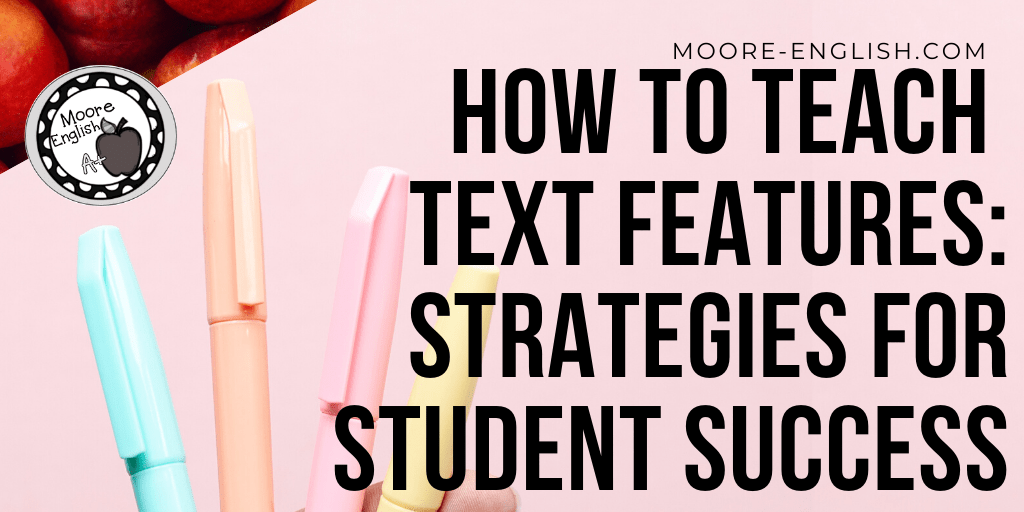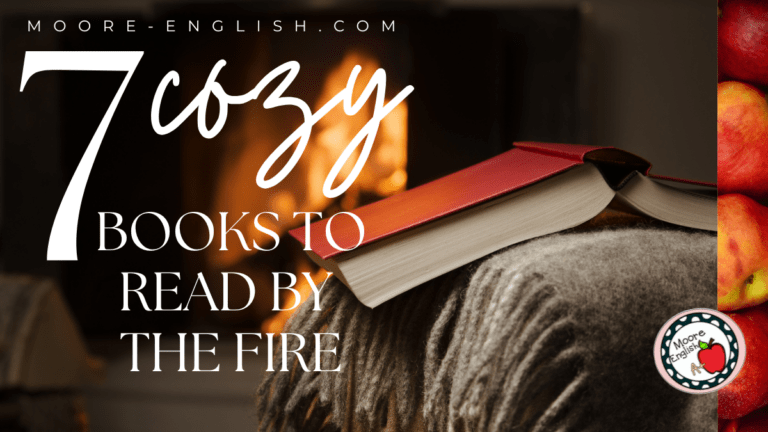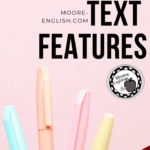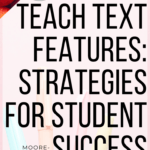Students overlook them. Standardized tests love them. And I didn’t know what to do with them. What am I talking about? Text features.
After years of apathy, I embraced text features and made them part of my professional growth plan. This is part of my teacher evaluation. By putting them into my evaluation document, I held myself accountable. Over the year, I learned lots of tips and tricks about teaching text features. And I wanted to share a few of my favorites with you.

This post this post may contain affiliate links. Please read the Terms of Use.
Vocabulary Matters
As I worked to emphasize text features in my instruction, I quickly found that they come with lots of domain-specific vocabulary.
Even in 9-12, it’s dangerous to assume that students are familiar with words like “index,” “preface,” or “caption.” For example, one of my students told me last year that he never read footnotes because they only included definitions.
Uh, well, that was a problem because footnotes contain all kinds of information. They do contain vocabulary, but they also include historical data, citations, and authorial insights. (Yes, yes, yes, I am a footnote nerd. During a recent class trip to the library, I picked up this book about Jay-Z and was thrilled about its footnotes.)
After this experience, I learned that the vocabulary of text features matters. Standardized tests often assume students have knowledge of academic vocabulary. So, as a class, we moved beyond calling footnotes “the number thing” and worked to call each feature by its proper name.
Some ways to explicitly teach this vocabulary include:
- Scavenger Hunt: Give students a list of text features that they must find in and around the classroom or library.
- Anchor Charts: This works especially well for charts, graphs, and captions. An anchor chart also works well for labor-intensive features like glossaries, indexes, and appendices that have special navigational requirements. This may seem elementary, but anchor charts are great quick references lend themselves to class-by-class differentiation.
- Concentration: Adding more movement to my instruction is one of my classroom goals this year, so I have designed several grammar games, including a this concentration set, to keep students engaged.
Choose Texts with Features
Choosing texts for a class can be challenging. However, when you’re focusing on teaching text features, it’s important to choose pieces that make good use of a variety of common ones. Here are some suggestions:
- Drama: Oftentimes, dramas appear in textbooks with a variety of text features including footnotes, paraphrases, illustrations, and questions. It’s no secret that I love teaching plays, but one of their advantages is that annotating a drama often requires students to reckon with dense language, and sidebars, footnotes, and captions help them do so. For this reason, I made sure to build text features into my abridged and modified versions of Shakespeare’s Romeo and Juliet, Julius Caesar, and Macbeth.
- Informational Texts: This is one of my favorites because it emphasizes several skill sets: conducting credible research and annotating. I use this in conjunction with these 4 steps for annotating nonfiction. Students use credible websites or databases to locate an informational read that matches their interests, and then students annotate the piece, including the text features. This can be a great place to start the research process or to help students build background knowledge.
- Poetry: Because poetry can be tricky, it often comes with helpful text features that help students “meet” an author, interpret a line, or learn about a technique. To help teachers locate quality texts, I’ve put together this set of 15 resources for finding new texts.
Annotate Text Features
Another way to explicitly teach this vocabulary is to simply use the language and give mini-lessons as needed.
For example, when modeling annotation, make sure to model annotating each feature. Students often over look text features, so including them in your annotations normalizes them and makes them an essential part of understanding an entire work. In other words, if you skip the text features, so will your students.
Another way to model annotating text features is to model the struggle. For example, when reading an informational text, I often model the frustration of working with an appendix or a glossary.
Then I engage in some thinking aloud and self-talk to show students how I manage my frustration.
In order to resolve my frustration, I model referencing the class anchor charts. There is no shame in referencing the anchor chart, so modeling that behavior normalizes it and helps students engage in the same problem-solving skills.
Get Creative with Text Features
My favorite way to help students engage with text features is to encourage students to include them in their own works. Here are some suggestions for helping students incorporate enhance their own work:
- Design a book cover for a narrative
- Add graphs and charts to informational writing
- Include illustrations or photographs with captions
- Include a credits page in multimedia presentations
- Use bulleted lists, italics, or bolding in presentations
- Create an About the Author page for any writing project
- Design an infographic to present research or build an argument
- Put together class writings into a magazine that has a table of contents
- Design maps and timelines to go with informational texts or create maps to go with creative writing
Probably my favorite way to encourage students to use text features is to give them a “menu” and ask them to choose 3 to include in their work. This provides students with some structure but also gives them some voice and choice so they can choose the features that best fit with their work.
Epilogue: Comfortable Teaching Text Features
After a year of focusing on teaching text features, I feel a lot more comfortable with helping students unpack them. I’ve even put together an entire Pinterest board dedicated to text features. What other tips and tricks should we know? Let us know in the comments!

Photo by Copper and Wild on Unsplash















